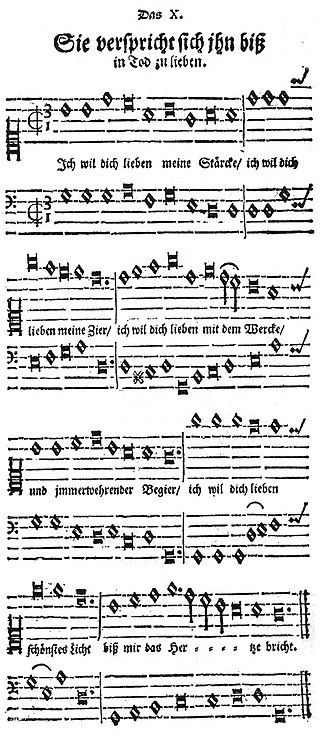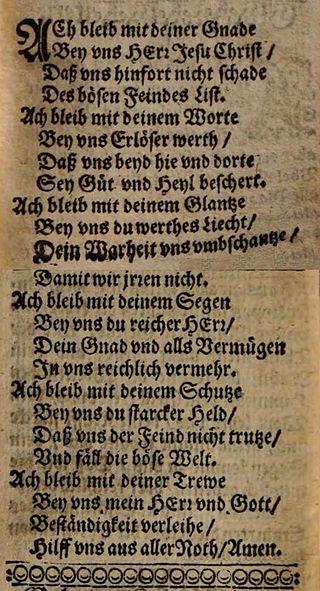
Angelus Silesius, OFM, born Johann Scheffler, was a German Catholic priest, physician, mystic and religious poet. Born and raised a Lutheran, he began to read the works of medieval mystics while studying in the Netherlands and became acquainted with the works of the German mystic Jacob Böhme through Böhme's friend, Abraham von Franckenberg. Silesius's display of his mystic beliefs caused tension with Lutheran authorities and led to his eventual conversion to Catholicism in 1653, wherein he adopted the name Angelus and the epithet Silesius ("Silesian"). He took holy orders under the Franciscans and was ordained a priest in 1661. Ten years later, in 1671, he retired to a Jesuit house where he remained for the rest of his life.
Advent songs are songs and hymns intended for Advent, the four weeks of preparation for Christmas. Topics of the time of expectation are the hope for a Messiah, prophecies, and the symbolism of light, among others. Several of the songs are part of hymnals such as the German Catholic Gotteslob (GL) and the Protestant Evangelisches Gesangbuch (EG).

"Glauben können wie du" is a Christian poem by Helmut Schlegel, written in 2009, and made a hymn of the genre Neues Geistliches Lied with a melody by Joachim Raabe the same year. It addresses Mary, the mother of Jesus, to be imitated living the theological virtues of faith, hope and love. The song is included in song books and the Catholic hymnal Gotteslob.

"Ich will dich lieben, meine Stärke" is a sacred poem by Johann Scheffler who is known by his pen name Angelus Silesius. It appeared first in a poem collection, Heilige Seelen-Lust in 1657, and has become a Christian song in notable hymnals of different denominations, with different melodies.

Georg Joseph was a German Baroque composer who served at the court of prince-bishop of Breslau. He was from 1657 to 1668 the musical collaborator of Johann Schefflers who published a collection of sacred songs titled Heilige Seelen-Lust oder geistliche Hirten-Lieder der in ihren Jesum verliebten Psyche, printed by the Baumannschen Drukkerey in 1657. 184 of the 200 Melodies with a bass line were written by Joseph. They were expressive and used occasional melismas to interpret the text.

"Das Grab ist leer, der Held erwacht" is a Catholic hymn for Easter, first printed in 1777 in the hymnal Landshuter Gesangbuch published by Franz Seraph von Kohlbrenner. Keeping only the first of five stanzas, with additional two stanzas, it appeared in hymnals of the 19th century, and later in different versions in several regional sections of the Catholic hymnal Gotteslob. It is a frequently sung hymn in Easter services.

"Im Frieden dein, o Herre mein" is a three-stanza German Christian communion hymn. In 1527 the early Reformer Johann Englisch wrote two stanzas as a rhyming close paraphase of the Nunc dimittis, or Canticle of Simeon. The hymn is sung to a melody by Wolfgang Dachstein, written before 1530. Friedrich Spitta revised the lyrics in 1898 and added a third stanza. His revision transformed Englisch's prayer of an individual with a focus on a peaceful death to a communal one more about peaceful life in unity.
"Christus ist erstanden! O tönt" is a Catholic hymn for Easter. It was written as a paraphrase of the Easter sequence Victimae paschali laudes, and appeared in 1816 by Johann Weinzierl. A melody was composed by Paul Schniebel in 1826. The first of six stanzas begins: Christus ist erstanden! O tönt, ihr Jubellieder, tönt!. The hymn is similar to Schubert's Deutsche Messe in its idea to provide singable hymns in German for the congregational.

"Gott ist gegenwärtig" is a Christian hymn in German by the Reformed writer Gerhard Tersteegen, published in 1729, based on a 1680 melody by Joachim Neander. The hymn, with the melody simplified, is part of the Protestant hymnal Evangelisches Gesangbuch as EG 165 and the 2013 Catholic hymnal Gotteslob as GL 387. Seven of its eight stanzas are part of the Mennonite hymnal as No. 1. The hymn is regarded as an expression of Christian mysticism. It was translated to English in various versions.

"Dein Lob, Herr, ruft der Himmel aus" is a German Catholic hymn. Adolf Lohmann adapted a 1659 hymn by the Jesuit astronomer Albert Curtz, who paraphrased Psalm 19. The melody appeared in Augsburg in 1669. It was No. 1 in the 1938 hymnal Kirchenlied and is part of the German Catholic hymnal Gotteslob as GL 381.
"Nun lässest du, o Herr" is a Christian hymn by Georg Thurmair written in 1966 as a paraphrase of the Nunc dimittis canticle. It was part of the German Catholic hymnal Gotteslob of 1975 as GL 660 with a 16th-century melody by Loys Bourgeois. With this melody, it is also part of the Protestant hymnal Evangelisches Gesangbuch as EG 695. It is part of the second edition of the Gotteslob as GL 500, with a new 1994 melody.
"O Licht der wunderbaren Nacht" is a Christian Easter hymn by Georg Thurmair written in 1963. It was part of the German Catholic hymnal Gotteslob of 1975 as GL 208, with a melody from the 14th century. It is part of the second edition of the Gotteslob as GL 334, also of regional sections of the Protestant hymnal Evangelisches Gesangbuch.
"Singt dem Herrn ein neues Lied" is a Christian hymn in German. It was written by Georg Alfred Kempf, a Protestant pastor in Alsace, in 1941. With a 1956 melody by Adolf Lohmann, it is part of the common German Catholic hymnal Gotteslob (2013).

"Macht weit die Pforten in der Welt" is a Christian hymn with German text by Albert Knapp written for the Basel Mission and first published in 1829. It appeared in 19th-century German hymnals, to be sung with the melody of "Wie schön leuchtet der Morgenstern". It appeared in the 1938 hymnal Kirchenlied with a new melody by Adolf Lohmann. The song is part of the 2013 German Catholic hymnal Gotteslob.
"Morgenglanz der Ewigkeit" is a Christian hymn with German text originally by Christian Knorr von Rosenroth, written around 1690 and set to music for private devotion. It became known with a 1662 melody by Johann Rudolf Ahle. The song is part of modern German hymnals and songbooks. It was translated to English as "Come, Thou Bright and Morning Star", and as "Dayspring of Eternity".

"Seht, der Stein ist weggerückt" is an Easter hymn in German with text written by the Catholic priest Lothar Zenetti in 1971. With a 2011 melody by Josef Oestemer, it became a Neues Geistliches Lied (NGL) published in 2013 in the Catholic hymnal Gotteslob, as GL 783 in the regional section for the Diocese of Limburg.
"Herr, nimm auch uns zum Tabor mit" is a Christian hymn with text by Peter Gerloff, written in 2001, with a melody by Richard Mailänder. The song was included in the Catholic hymnal Gotteslob.
"Selig, wem Christus auf dem Weg begegnet" is a Christian hymn with words in German by Bernardin Schellenberger written to match a 1681 Parisian melody. It appeared in the German hymnal Gotteslob.

"Ach bleib mit deiner Gnade" is a hymn with text by Josua Stegmann" written in 1627. The melody is taken from "Christus, der ist mein Leben", a 1609 song by Melchior Vulpius that became one of the key melodies in Protestant hymnody. It is part of several current hymnals, the Protestant Evangelisches Gesangbuch as EG 347, the Catholic Gotteslob as GL 436 and the Mennonitisches Gesangbuch as MG 149. It belongs to the ecumenical hymns.











